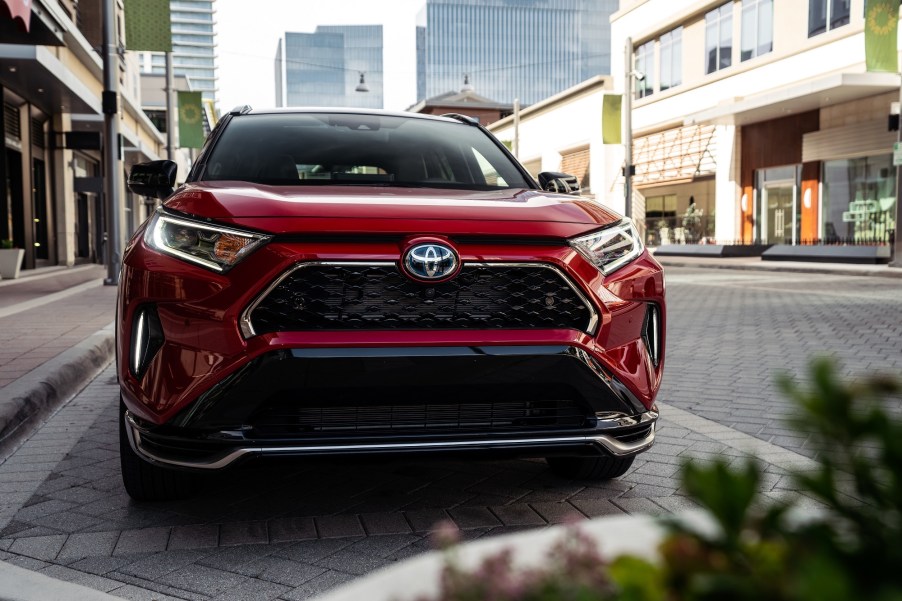
Does the Toyota RAV4 Prime Qualify for the Federal Tax Credit?
One of the biggest incentives for purchasing an all-electric vehicle or plug-in hybrid vehicle is the potential for a hefty tax credit. And, of course, there are also the environmental benefits. So if you’re looking at Toyota’s line of EVs and PHEVs, you might want to know if the 2021 RAV4 Prime qualifies for the tax credit.
In fact, yes, it’s eligible for a sizable credit. It also packs plenty of power and has one of the best gas mileage estimates in the hybrid SUV class. Plus, it doesn’t hurt that the RAV4 is Toyota’s most popular SUV in sales and reviews from critics and consumers alike.
What is the federal tax credit for EVs and PHEVs?
Fueleconomy.gov — the official U.S. government source for all things related to fuel economy — maintains a list of all new EVs and PHEVs that qualify for the federal tax credit and the dollar amount of the credit. Vehicles must be new and purchased in or after 2010. In addition, the amount of the tax credit is based on the vehicle’s battery capacity. Also, the credit applies only to vehicles with an external charging source and a battery capacity of at least 4 kWh.
All of the EVs on the list qualify for the full $7,500. Some PHEVs, such as the Toyota RAV4 Prime, are eligible for the full $7,500, but most PHEVs qualify for only a partial tax credit.
Click here for our guide on how to claim the $7,500 tax credit for the RAV4 Prime.
Why is the Toyota RAV4 Prime eligible for the tax credit but other new EVs, such as Teslas, are not?

The 2021 Toyota RAV4 Prime qualifies for the full $7,500 tax credit because of its larger battery, Kelley Blue Book reports. The credit is calculated using a rate of $417 per kWh above 4 kWh, with a maximum of $5,000, added to the base credit, $2,500, for which all eligible vehicles qualify. Because the RAV4 Prime packs an 18.1-kWh battery, it qualifies for the full amount.
Some notable vehicles are missing from the government’s list, including all Tesla models. And it has nothing to do with battery size. Unfortunately for companies like Tesla that have been successful in the EV market, the tax credit begins to phase out after the first 200,000 vehicles are sold. Typically, the tax credit expires about one year after the 200,000th sale.
Tesla is not the only manufacturer that has become ineligible for the federal tax credit. General Motors is also no longer eligible, and Nissan is the next manufacturer in line.
Overview of the 2021 Toyota RAV4 Prime
Starting at $38,350, the 2021 Toyota RAV4 Prime packs a powerful 2.5-liter inline-four engine producing 177 hp and 165 lb-ft of torque. It works with three electric motors, two up front, putting out 179 hp and 199 lb-ft of torque, and one in the rear, producing 53 hp and 89 lb-ft of torque. That’s a total of 302 hp, for a 0-to-60-mph time of 5.7 seconds, Toyota claims.
The RAV4 Prime is not only fast but also fuel-efficient. It gets an EPA-estimated 94 MPGe with a fully charged battery and 38 mpg for gas only. The large 18.1-kWh battery provides 42 miles of all-electric power and a total range of about 600 miles of combined power.
Inside, the RAV4 Prime is relatively spacious and comfortable. And thanks to the location of the battery, it doesn’t take up valuable cargo space. The base-model SE comes with a bevy of driver assists, LED headlights, and an 8.0-inch infotainment display. And the higher trim level, the XSE, adds steering-wheel-mounted shifter paddles, larger wheels (19 inches instead of the base trim’s 18 inches, blind-spot indicators, and rear cross-traffic alert.
EVs and PHEVs offer numerous benefits for the environment in addition to fuel savings. And when you consider the federal tax credit — along with potential incentives in your state and the perk that some areas allow the Toyota RAV4 Prime to travel in HOV lanes regardless of the number of occupants — it ends up being a fairly affordable SUV. Plus, who doesn’t dream of driving in the HOV lane without any passengers?


